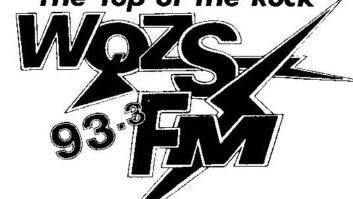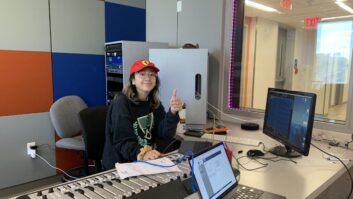
Monte Sieberns uses the Braille Sense U2 in the studio. According to an account by www.reelclassics.com, the classic quote originated in the syndicated newspaper cartoon Frank and Ernest in 1982. It depicted a movie marquee for a Fred Astaire film festival. Two guys stood in line ready to enter the theatre; a woman says to them, “Sure, he was great, but don’t forget that Ginger Rogers did everything Astaire did, but backwards and in high heels.”
So it is with WJOT(FM)’s Monte Sieberns. He does everything other radio personalities do, but without the power of sight.
“I am blind from birth, and I naturally gravitated toward sounds,” he said. “My father is a farmer who listened to WOWO(AM) Ft. Wayne for the farm reports. I wanted to be that voice coming out of the speakers.”
Sieberns, 44, has been the voice of “Monte’s Music Shop,” heard live from noon to 5 p.m. weekdays, since April, 2007 on the Wabash, Ind., station. For a short time, when WJOT was searching for a new morning man, Sieberns also held down the 6–9 a.m. air shift.
From kindergarten through 12th grade, Siebens attended Indiana School for the Blind, which not only taught him his ABCs but also skills such as negotiating public transportation, traversing an unfamiliar room and other tasks sighted folks take for granted.
In his teens, Sieberns found some work in radio; but finding a full-time slot was not easy.
GETTING A GIG
“My audition tapes would pass muster, but in the interviews they’d see I was blind and that would put a damper on things. The managers were trying to imagine themselves in my situation, and it scared them, which is understandable,” he said. “But successfully dealing with my blindness is all I know. It’s not as if I had sight and lost it. Over the course of my whole life I have adapted.”
Sieberns endured a short stint in a broadcast school and found it to be less than helpful.
“They would ask stupid questions like ‘How many feet of tape are there on a 10-inch reel?’ Radio, it’s not about theory; it’s about creating a sound,” he said.
Sieberns found part-time jobs at various stations in Indianapolis and Vincennes, Ind., but by 1988 he still couldn’t find full-time employment on the air. Thus he began working behind the scenes building music libraries for stations and serving as a DJ at weddings, endeavors he continues to this day.
“I was tuning around the dial, feeling kind of maudlin about not being on the air,” he said. “I discovered WJOT and called the operations manager and offered to work on the air. He didn’t need an air personality at the time, but the general manager did need help building an MP3 music library his staff could access from computer.”
This led to an unusual — but successful — live audition.
“I invited the sales manager and the general manager down to my home studio,” said Sieberns. “I told them that before I handed over the first volume of music I wanted to test it. I can’t tell you the reason, but when the introduction to the first song came out of the speaker, I began talking over it like I was on the air. I even included their dial position. They both sat there and said, ‘Whoa, we could use that.’ I said, ‘Here I am. You want me to come in today?’”
TAKE A CHANCE ON ME
The next Thursday, Sieberns found his way to the station with the assistance of his twin brother, Marty, who is not blind. Monte Sieberns had a chance to use his hands to get familiar with the board and then said, “OK, let’s go on the air!” The following Saturday morning he was brought in to run the board for a remote broadcast.
“It’s awesome that these guys were willing to take a chance on me,” he said. “One thing that helped was that I brought in my own adaptive equipment.”
And these self-taught techniques and specialized pieces of gear make the difference when it comes to establishing independence for the blind.
“At first, I had to have someone read the log to me, but that’s changed now. Someone just emails it to me, and I can display it in Braille. We use a program called StationPlaylist (www.stationplaylist.com), and I have another program called Window Eyes (www.windoweyesforoffice.com) that reads the screen to me with a synthesized voice. So now I can get the record title, artist name, song length, etc.”
While Braille is an old technology, it’s been brought into the 21st century with Braille Sense U2 (hims-inc.com). This software uses “refreshable Braille” incorporating metal pins that pop up and down electronically replacing the traditional paper chad.
Sieberns also carries several portable devices including an Olympus LS-100 multi-track PCM recorder and a Plextalk (www.plextalk.com), a CD/Flash recorder. He uses the latter to record stock market reports via his iPhone, a device that comes adapted for the blind directly from the factory. His bag of tricks also includes a Perkins Brailler (www.perkinsproducts.org) that stamps out traditional Braille text onto stiff paper for those pieces of copy that will be read repeatedly.
His gear includes a remote mixer for combining his voice and music for commercials, his own thumb drives and SD cards. Not completely necessary — but always handy — is the 14 terabytes of music he has collected. For remote broadcasts, Siebert takes advantage of his senses of hearing, taste, touch and smell. For example, at a restaurant he samples the wares and tells the audience about the delicious taste.
“I paint an audio picture for the listener,” he said, “like when I was at this used car dealership, and I sat inside a car and described what it was like. Or when I was broadcasting from a jewelry store, and I could feel the etchings in the jewelry.”
Wade Weaver, owner of WJOT, was one of the men who initially recognized Siebern’s talent and gave him his break on the air.
“My biggest accomplishment as a radio operator is helping Monte achieve his dream to become an FM disk jockey,” said Weaver. “He’s an amazing announcer, and there is nothing he can’t do on the radio.”
Most WJOT listeners know that Sieberns is blind, though he doesn’t emphasize the fact on the air.
“My hopes are that I can open up this world for people and make them more comfortable with it,” he said. “Very rarely will it upset me to deal with my blindness, but when I have a rough day I kick myself in the butt and say, ‘You’re here, deal with it!’ Usually, I run around the building without my cane, which I shouldn’t do because you never know when someone has rearranged the furniture.”
Ken Deutsch started his writing career with grocery lists, graffiti and anonymous MASH notes to his elementary school teachers. Look where he is now.
Comment on this or any story. Write to [email protected].












